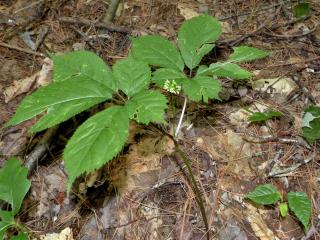

A rather small perennial native to Asia, about ten different species are sown and grown across the planet. Ginseng has been known for millennia in traditional medicine.
It grows on mountain slopes in North-East China, in Russia, Korea and Hokkaido island in North Japan.
This plant bears palmate, lobular leaves, whitish flowers clustered in umbels from which small red-colored berries are formed.
It grows in size to between 12 and 20 inches (30 to 50 cm): age is what makes the plant larger, and the medicinal properties of the plant depend on how old the plant is. For maximum potency, this plant must be grown for at least 6 or 7 years, giving the roots enough time to mature and acquire all their beneficial properties.
That’s why herbal medicine standards always use plants that are at least 5 years old.
Today, this plant has become very rare in the wild. It is mostly cultivated in North-Eastern China and in South Korea.
But what about the famed benefits of ginseng that the medical field praises so? What ailments does it soothe? How and why does it work? Here is what you need to know…
The root word that led to today’s word “ginseng” is said to have come from the mandarin Chinese word “rénshēn”. Indeed, the prefixe “rén” designates the “human being” and the “shēn” part means “root”.
For the past four millennia, ginseng has been a fundamental building block of Asian medicine, among which the Korean, Chinese and Indian knowledge stands out.
According to certain writings of Indian literature, ginseng is considered a plant that has magical powers, the power to give life.
Some of the first ethnographers relate that American Indians used it to enhance fertility in women, while also using its beneficial properties to strengthen health for elderly persons.
According to legend, ginseng helped give birth without suffering.
Moreover, in the Far-East, this beneficial plant is often appreciated for its reinvigorating activity.
Indeed, it is said to have tonic properties for the human body’s immune system across all of its functions (hormonal, digestion, nervous, urinary…).
While in China and in North Korea, emperors and powerful warlords had been using it for 4000 years, people from the West only started discovering its health benefits in the XVIIIth century, when they started using it as a fortifier, an aphrodisiac and a nervous stimulant.

It goes by the name “white ginseng” when the root is simply washed and dried; and by the name “red ginseng“ when it is first steamed before being dried.
There are also false ginsengs which have therapeutic properties that are quite close to those of Korean ginseng for some of its claims: anti-fatigue, stimulant, aphrodisiac… These are the Indian ginseng or Ashwagandha and Peruvian Maca.
But these false ginseng plants are called “false” because they don’t contain any ginsenosides, which are Ginseng’s most potent active compound.
With incredible names such as “King of herbs”, “Heaven’s root”, “World marvel”, the medicinal herb of the Panax genus is replete with innumerable health benefits that can increase overall well-being. The scientific name “Panax itself comes from the Greek word “panakos” which means “that which heals all”.
Red ginseng has been part of traditional Chinese medicine for at least 2,000 years. Various peoples and cultures have been using ginseng root for a very long time for its health benefits.
Ginseng is also described as an excellent adjuvant in treating various diseases, among which:
Indeed, scientists have proven that Korean ginseng or Panax ginseng stimulates and fortifies the nervous system for patients who are wounded or sick, physically exhausted and persons suffering from long-term emotional stress.
This ginseng variety can also help:
To sum it up, simply remember that Asian ginseng contributes to better overall health and well-being.
In modern herbal medicine, ginseng is among the herbs or substances that are said to be adaptogen, which is to say they regulate the body’s internal functions by constantly searching to balance things out.
To stimulate the immune system, it is recommended to ingest normalized extracts (4 to 7% ginsenosides), either 100 mg or 200 mg, twice a day.
For sexual, intellectual, physical or post-operative stimulation, the patient can choose among:
Note that you can find food supplements prepared from ginseng root that can be purchased in wellness centers, specialized stores and even in supermarkets.
Ginseng is quite the universal remedy.
Taking ginseng should not be practiced without first seeking advice or counsel from a specialist doctor.
Note that diabetic persons must be monitored if ingesting ginseng, since the preparations and dosages vary greatly: there is thus no generic treatment and each must be tailored to the patient’s situation.
Before ingesting the plant, read the labels well on the product bottle, to know the certified Panax ginseng content.
The tonic effect of ginseng root, when taken in excess, can trigger anxiety or insomnia.
It is thus strongly recommended to follow through with a medical consultation before starting a course.
Do not get this plant confused with the ginseng ficus tree, a purely ornamental ficus.
I am impressed to see the garden and also interested to build a garden like that. Can you please let me know if it would be possible to build a garden in Virginia, USA area? Where the winter temperature maybe sometimes drop below 10 degrees F?
Hi Matin! Well, 10°F is a bit cold to grow ginseng commercially. It would grow faster in warmer climates.